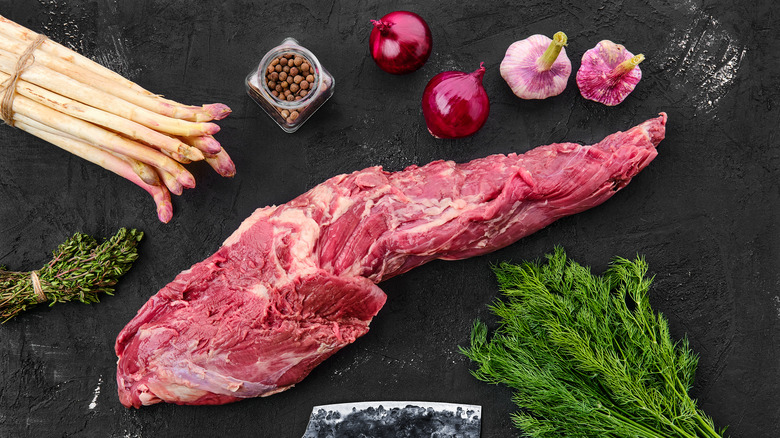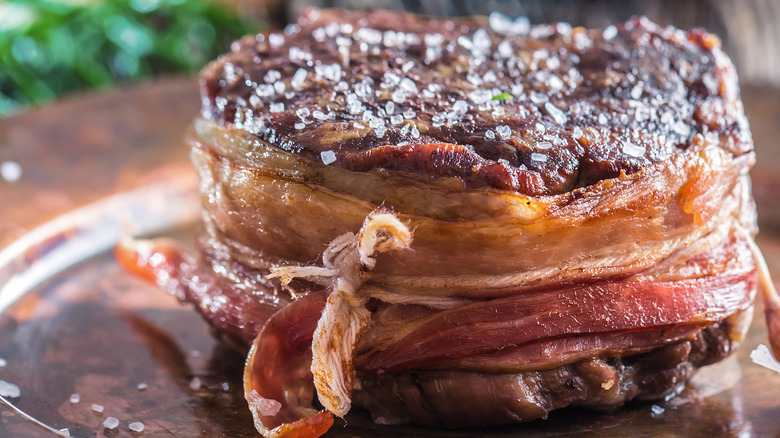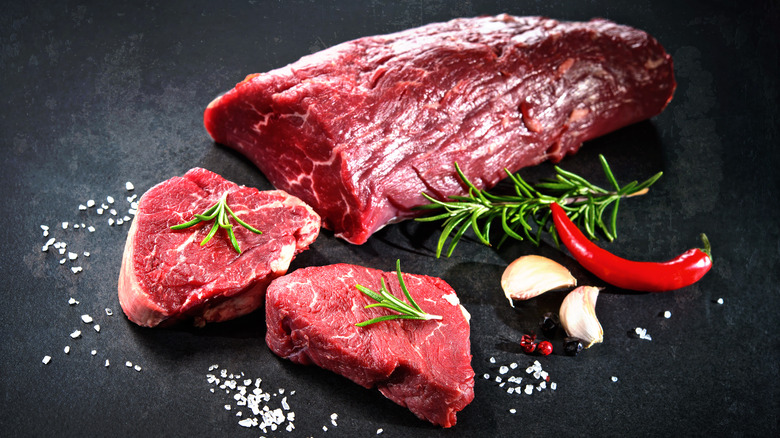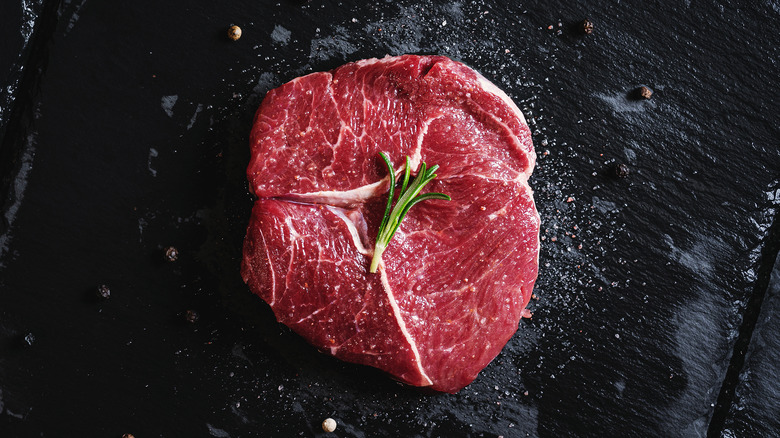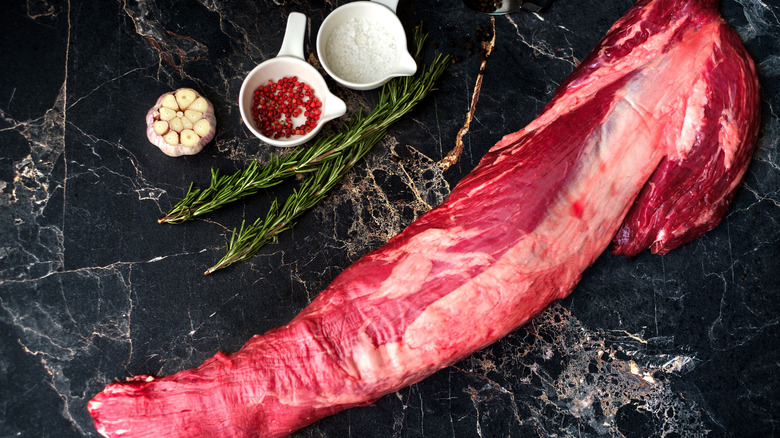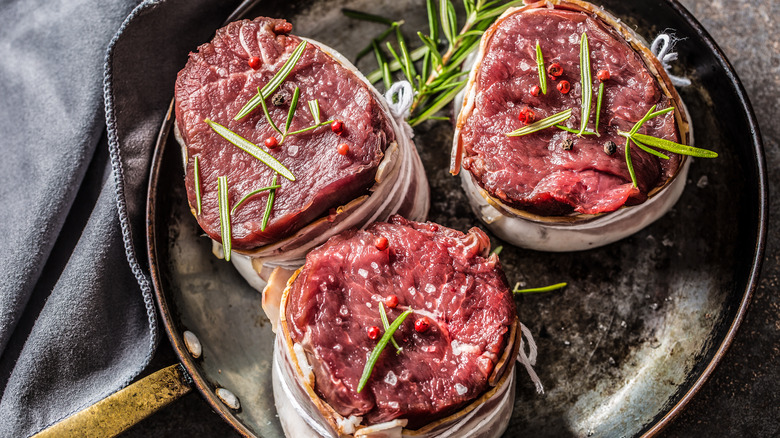Everything You Should Know About Tenderloin Steak
If you are looking for a nice piece of steak to relish solo or one that will surely impress your guests, you cannot go wrong with a tenderloin. According to The Spruce Eats, the tenderloin is the most expensive steak for good reason: it's quite literally a "tender loin." The tenderloin, or psoas major, is an oblong muscle extending from the rear of the spine from near the hip bone to the thirteenth rib. This particular muscle doesn't get exercised a lot, making it the most tender cut of beef.
Also known as a filet, according to Food Network, the tenderloin is lean without as much fat as other steak cuts. Those yummy white pieces of intramuscular fat, or marbling, you get in other cuts accounts for a lot of those steaks' moisture and flavor. According to The Spruce Eats, without the marbling, it is less-flavorful when compared to fattier cuts, but one way to take the flavor and moisture up a notch is by wrapping your tenderloin in a piece of bacon. (No arm twisting required there!)
Here's what else you need to know about tenderloin steak before you start cooking.
Is a tenderloin the same as a filet mignon?
Filet mignons are medallions cut from the portion of the tenderloin that is near its thinner tip (via The Spruce Eats). According to Google Translate, "mignon" comes from the French word for "cute," and these steaks are indeed cute little chunks of filets. But, if you're thinking these two steaks have a lot in common, you are onto something. According to My Chicago Steak, the reason beef tenderloin and filet mignon look and taste similar is because they are both cut from the tenderloin. While we know the filet mignon comes from the skinny end, the beef tenderloin is taken from the longer end.
According to My Chicago Steak, though the beef tenderloin is larger than a filet mignon, it is smaller than a number of cuts of steak, including the larger round, rib, and chuck — and it costs more per pound than those cuts because it doesn't have as much meat. Beef tenderloins are also pricier because they are so tender (worth every penny!), but not as tender as a filet mignon. This area produces a "melt-in-your-mouth texture when cooked," according to My Chicago Steak. (Yes, please!) Upping the cost even further is the fact that each beef tenderloin only yields a few filet mignons. Just go ahead and take all our money!
Where should you purchase tenderloin and how much should you buy?
Tenderloin should not be too hard to find. According to The Spruce Eats, you can likely find it at the meat counter in your local grocery store or you can buy it from a butcher. The outlet advises that, when purchasing, try to secure a steak that is around one-and-a-half inches thick to make cooking it to medium rare that much easier.
But, how much steak should you buy? According to The Spruce Eats, a tenderloin usually weighs between 4 and 7 lbs. Here's where the math comes in: If each pound serves around four diners, that means a 4-lb. tenderloin could potentially serve 16 guests. McCormick, on the other hand, puts the meat-to-person ratio higher and recommends planning for eight ounces of meat per guest — that's one way to get our RSVP! — or six ounces if you are offering it up with substantial side dishes.
Here are the three main cuts of tenderloin
There are three main cuts of tenderloin, according to Beef 2 Live: the butt, the center-cut, and the tail. If the tenderloin is cut from butt to end, it will result in very thin steaks. The butt can be used for carpaccio, a thin piece of steak served raw, while the center-cut can be cut into even-sized steaks since the diameter is close to consistent throughout.
The center cut is where you can get those delightful filet mignons or pieces for another tenderloin dish, like a Beef Wellington, which is a beef tenderloin prepared in layers of pâté, mushroom mix, parma ham, and puff pastry, according to MasterClass. The tail, however, is not consistent in diameter, but pieces from this cut can still be used in recipes that call for small, tender pieces of steak, like beef stroganoff (via Beef 2 Live). The center-cut can be roasted whole and should be enough steak for four to six guests, according to McCormick, while a tail-end tenderloin can feed a larger dinner party.
Should you buy tenderloin steak trimmed or untrimmed?
Another consideration when purchasing tenderloin steak is whether to opt for buying it trimmed or untrimmed. According to McCormick, untrimmed tenderloin will have the fat and silverskin still intact. Silverskin is just connective tissue that needs to be removed before cooking because it is tough and chewy (two undesirable attributes when it comes to steak), and won't melt during cooking (via Cuisine at Home).
If you do leave the silverskin on, Cuisine at Home cautions that it will shrink, twist, and turn the meat into a "corkscrew." Instead, the outlet recommends removing it by first pulling off as much fat as you can with your hands. Then, locate the part that looks like packing tape, or the silverskin, and slip a sharp, narrow knife under it to make a "tab." Grab the tab, and run the blade (carefully!) underneath it leaving as much meat behind as possible.
According to Cuisine at Home, a whole tenderloin will also have a "chain," or a thin, fatty piece of meat that runs the length of the entire tenderloin. You should be able to remove this piece by hand, and you can even use it in a stew later. Of course, untrimmed steak is a little cheaper because it means more work for you, but according to McCormick, the butcher will likely trim a tenderloin, and unless you are Alice Nelson, it will probably cost you a little more cash.
Tips for cooking tenderloin steak
Some sexy cuts of steak, like T-bones and porterhouses contain a section of tenderloin. But, if you plan on cooking a whole tenderloin, which is thicker on one end than the other, the skinny end might prove to be a challenge since it is smaller than the rest of the steak. This can cause it to cook quicker than the rest. To combat overcooking, The Spruce Eats suggests folding over the smaller tip and tying it to the body of the roast — a task you might also be able to bribe your butcher to do for you, according to Cuisine at Home.
If you want to try your hands at cooking a filet mignon, Delish recommends starting the steak in a super-hot, cast iron skillet and finishing it off in the oven. As far as seasonings go, the outlet uses olive oil, butter, black pepper, rosemary, and Kosher salt, and advises: "A nice, salty crust is absolutely key for filet mignon." But, if you cannot stop thinking about that aforementioned bacon, Food Network has a recipe that just might be calling your name.
